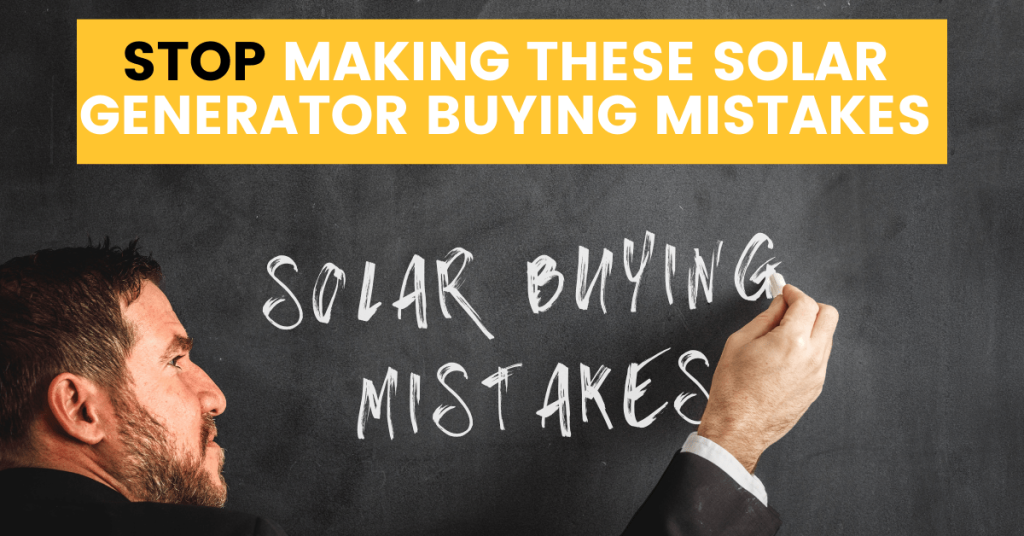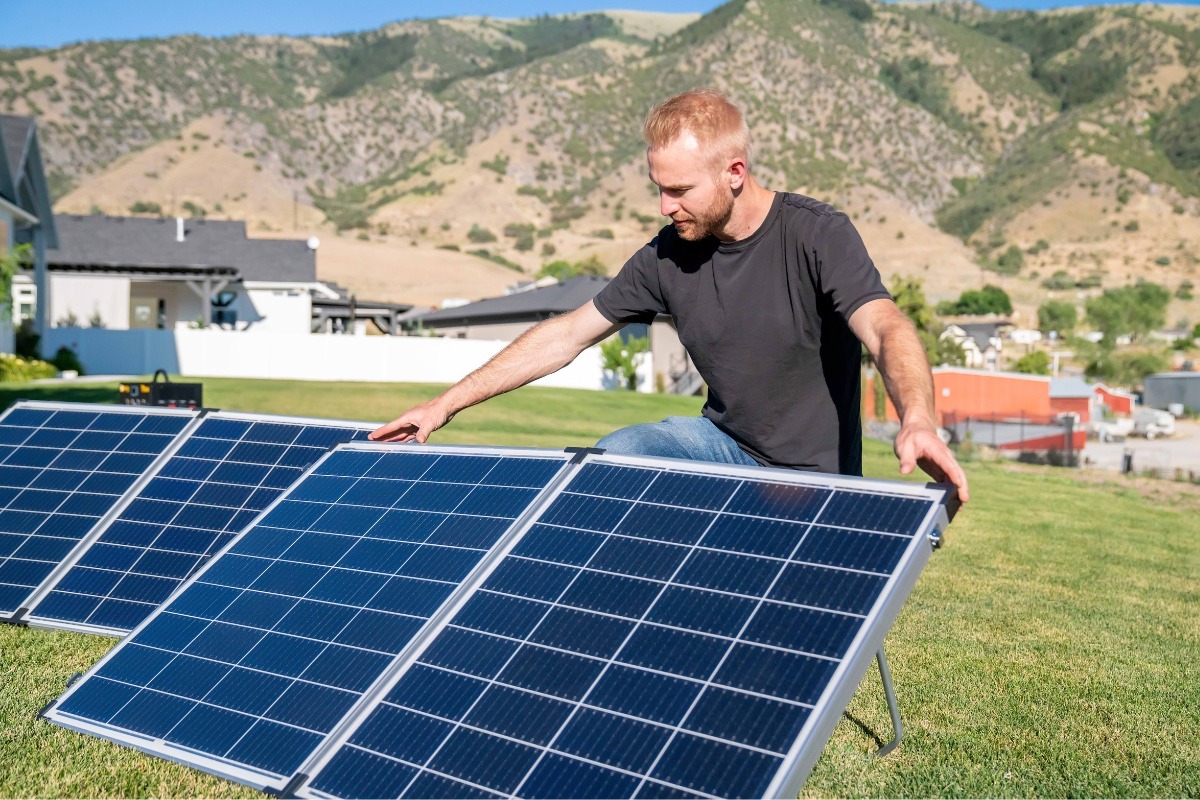When it comes to portable solar power, not all solar generators are created equal. With so many options available, it’s easy to get overwhelmed and make the wrong choice and fall for one of the common solar generator buying mistakes. Before you make a purchase, it’s important to know what to look for and what to avoid. In this article, we’ll go over some of the red flags to watch out for when shopping for a solar generator. Without further ado, here are our top 10 solar generator buying mistakes.

The first solar generator buying mistake on our list is a solar generator with too small of an inverter. The inverter is one component you will not be able to upgrade, so it’s important to choose the right size from the beginning. The inverter is a critical component of a solar generator, as it is responsible for converting the direct current (DC) electricity produced by the solar panels or battery into alternating current (AC) electricity that can power your devices and appliances. It is also responsible for providing the necessary surge power to start up appliances with motors, like refrigerators, air conditioners, and power tools.
When selecting a solar generator, it is crucial to consider the size of the inverter, as it will determine the maximum wattage that can be supplied to your devices. If you plan on running appliances with a high starting surge, it is essential to choose an inverter that is powerful enough to handle the load. Otherwise, your devices may not start or could be damaged.
Efficiency is a crucial factor when it comes to solar power systems, especially when you’re looking for a reliable and cost-effective option. It is important to choose solar generators that are designed to operate with minimal energy loss. A good way to determine this is by looking for the idle power consumption and power save mode of the generator. A generator with an idle power consumption of less than 20 watts ensures that the system will not consume too much power while it’s not in use. Meanwhile, the power save mode feature that has a consumption of less than 10 watts helps to save on energy bills by automatically turning off non-essential components when they are not in use. By investing in a solar generator with these features, you can rest easy knowing that your system is operating at optimal efficiency and you’re saving money in the process.
Buying Mistake #3: Solar generators with modified sine wave inverters
Pure sine wave inverters are a highly recommended investment for those who plan to use their solar generator to power sensitive electronic devices such as laptops, TVs, and other electronics. Although they may come with a higher price tag compared to other types of inverters, the benefits they offer are well worth the investment.
One of the primary advantages of pure sine wave inverters is that they produce cleaner power than other types of inverters. A pure sine wave inverter produces a smooth, continuous wave that is similar to the power provided by your local utility company. This makes them ideal for powering delicate electronic equipment as they mimic the same type of electricity that is provided by the electrical grid.
Moreover, pure sine wave inverters are less likely to cause damage to sensitive electronics compared to other types of inverters. Devices that require precise voltage and current levels, such as computers and medical equipment, are less likely to malfunction or become damaged when using a pure sine wave inverter. This is because they provide a stable and reliable source of power, ensuring that your devices are operating at their optimal level.
When choosing a generator for long-term use, it is important to select one with sufficient battery storage capacity. A generator with less than 2000 watt-hours of storage is unlikely to provide adequate power for prolonged use.
To ensure you choose the right generator, it is crucial to determine your power requirements based on the devices you plan to power. Adding up the total power requirements of all your devices will help you determine the amount of battery storage you need.
Selecting a generator with enough battery storage capacity will offer several benefits. It ensures that you can power your devices for an extended period without the need to recharge the generator. This is particularly important in emergency situations or when off the grid.
Different types of batteries have their own strengths and weaknesses, and it is important to choose the right one for your needs. Two common types of batteries used in solar generators are AGM and Lithium.
AGM batteries are a versatile option that works in almost any temperature, is efficient, and can handle deep 100% cycles. Good quality ones can last 10 years or more with a battery maintainer, but they are heavy and have a shorter lifespan than lithium batteries. They also need to be fully charged to last long.
Lithium batteries are lightweight, have almost zero self-discharge, and can handle more cycles than AGM. They don’t need to be fully charged to maintain their long life. However, they cannot be charged below 32 deg. F.
When considering a solar generator, it is essential to keep in mind that the device’s solar panels are what allow it to generate electricity. Without them, the device is essentially just a battery with limited capacity that can only be charged through a wall outlet or a car charger. Therefore, it is crucial to ensure that your solar generator comes with an adequate solar panel to meet your energy needs.
A good rule of thumb is to choose a solar generator that comes with at least 200 watts of solar capacity. This amount of solar power is usually enough to power small appliances such as laptops, phones, or small refrigerators. However, if you have higher energy demands or plan to use your solar generator for extended periods, you may want to consider a generator with more solar capacity.

One crucial factor to consider when choosing a solar generator is the recharge time. It’s important to make sure that the recharge time of your solar generator is manageable, especially during times of low sun exposure. Winter and cloudy days, for example, can reduce the amount of sunlight that your solar panels receive, making it more challenging to recharge the battery fully. In addition, since there is no sunlight during the night, it’s essential to have a solar generator that can recharge quickly during the day so that you can use it at night.
Choosing a solar generator with a manageable recharge time ensures reliable usage, even during times of reduced sun exposure. A shorter recharge time allows you to recharge your generator quickly and efficiently, ensuring that you have a reliable power source when you need it the most. Moreover, with a manageable recharge time, you can rest easy knowing that you won’t run out of power when you need it the most.
When it comes to solar power systems, the type of charge controller you use can make a big difference in the amount of energy you can generate. MPPT (Maximum Power Point Tracking) charge controllers are a popular choice due to their high efficiency and ability to produce more power with less sunlight.
Compared to PWM (Pulse Width Modulation) charge controllers, MPPT charge controllers are more efficient as they can track the maximum power point of your solar panels, which means that they can extract the maximum amount of energy available. This results in more energy being produced with less solar input, making them a cost-effective and sustainable option.
Furthermore, MPPT charge controllers are better suited for use during cloudy weather. In low light conditions, PWM charge controllers can struggle to convert the limited power generated by solar panels into usable energy. On the other hand, MPPT charge controllers can adjust their output to optimize the limited power input and ensure maximum efficiency.
Although MPPT charge controllers may cost more than PWM controllers, the benefits they offer make them a wise investment. With their superior efficiency, ability to extract maximum power, and suitability for use during cloudy weather, MPPT charge controllers are an excellent choice for anyone looking to maximize their solar power system’s potential.
When choosing an MPPT charge controller for your solar power system, it’s important to consider its voltage input range. A good MPPT charge controller can handle panel voltages of up to 100VDC, making it a versatile option for different solar panel configurations.
However, some lower-end MPPT charge controllers have a narrow voltage input
range and cannot be considered true MPPT charge controllers. These controllers may be cheaper, but they limit your options when it comes to upgrading your solar panels or expanding your solar power system.
To ensure that you have the flexibility to upgrade your solar panels and expand your solar power system, it’s crucial to choose a generator with a flexible voltage input range. This will allow you to use a wide range of solar panel configurations and upgrade your system easily in the future.
The last solar generator buying mistake is choosing a portable solar system that cannot grow with you. Being able to expand and grow with your changing needs is essential for maximizing the longevity and functionality of your system. While it’s important to purchase a system that meets your current needs, it’s equally crucial to consider the potential for future expansion and upgrades.
Investing in a solar system that is designed to be scalable and adaptable ensures that you can add more solar panels or batteries as your energy needs change over time. This will not only increase the efficiency and sustainability of your system but also save you money in the long run by avoiding the need to purchase an entirely new system down the line.
When selecting a portable solar system, it’s important to consider the scalability of both the solar panels and batteries. If your batteries cannot be expanded, it may not make sense to invest in additional solar panels as the excess power generated would have nowhere to go.
In conclusion, choosing the right solar generator can be a daunting task, but it is worth the effort to ensure that you get the most out of your investment. Avoiding the common solar generator buying mistakes mentioned in this article will help you to make an informed decision and choose a solar generator that fits your needs. Remember to prioritize factors like inverter size and type, battery storage capacity, solar panel compatibility, charging time, and charge controller type when making your decision. With the right solar generator, you can enjoy the convenience and flexibility of portable power for all your off-grid adventures. So, take your time, do your research, and choose a solar generator that will give you the power you need, when you need it.

Norris Davis says:
My solar panels would need mounted on a roof 110 feet from my house. Will your system work any possible way with any extended cables. Need a Titan generator/panels/every from your company for solar power.
Point Zero Energy says:
Yes, it can easily work 110 feed from your house. Our kits come with up to 100 feet extensions, but you can buy another extension to make it longer.
Robert Bornemann says:
Very interesting this has me thinking know also made in USA!!!